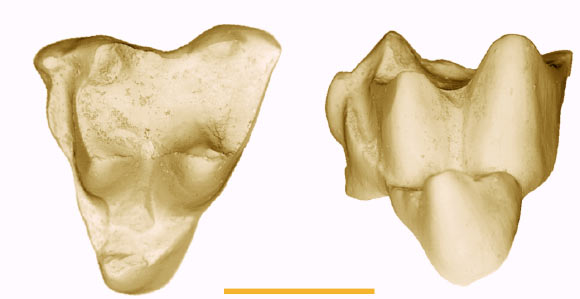Two tiny marsupial fossils from Australia are prompting an overhaul of theory about marsupial evolution after they revealed unexpected links to South America and Africa.

Only known specimen of the Early Eocen marsupial Archaeonothos henkgodthelpi from southeastern Queensland, Australia; scale bar – 1mm (Robin M.D. Beck)
“The origins of Australian marsupials suddenly got a lot more complicated,” said Dr Robin Beck from the University of New South Wales.
One of the fossils, found at the Tingamarra site in southeastern Queensland, is a 55 million-year-old ankle bone from a mouse-sized marsupial previously known only from South America.
“All the species of modern day marsupials here are quite closely related. The species represented by the ankle-bone belongs to an entirely different group – a group that we know lived in South America but, up until now, we thought never made it to Australia.”
The second is a tooth, which derives from a formerly unknown species that shows similarities to fossils found in South America and, surprisingly, North Africa.
“The tooth is more of a mystery: are its origins in South America, Africa or somewhere else?” said Dr Beck, who described this fossil in a study published online in the journal Acta Palaeontologica Polonica.
The two fragments are set to overturn the conventional theory about the evolution of marsupials, which holds that there was a single migration from the part of the Gondwana ‘supercontinent’ that became South America to the part that became Australia.
“It is impossible to explain the presence of these new fossils in Australia using the single dispersal model. Instead, there may have been multiple movements of marsupials between South America and Australia.”
Because the fossil tooth comes from a species previously unknown to science, Dr Beck had the honor of formally describing and naming it.
“I’ve named it after one of my colleagues, Dr Henk Godthelp, who has led research at Tingamarra together with Mike Archer and Sue Hand. Henk’s nickname is ‘The Old Bastard’, so I’ve called the species Archaeonothos henkgodthelpi, which translates, roughly, to ‘the ancient illegitimate of Henk Godthelp’. The name also implies the species is unrelated to other Australian marsupials.”
The similarities between the fossil tooth and those of an extinct species recorded in Tunisia remain the tantalizing subject of further research.
For the moment, though, Dr Beck thinks the tooth and the ankle-bone – which he described in the German journal Naturwissenschaften – provide fascinating new information about the history of marsupials in Australia.
______
Bibliographic information: Robin M.D. Beck. 2013. A peculiar faunivorous metatherian from the early Eocene of Australia. Acta Palaeontologica Polonica, in press; doi: 10.4202/app.2013.0011
Robin M. D. Beck. 2012. An ‘ameridelphian’ marsupial from the early Eocene of Australia supports a complex model of Southern Hemisphere marsupial biogeography. Naturwissenschaften, vol. 99, no. 9, pp. 715-729; doi: 10.1007/s00114-012-0953-x







